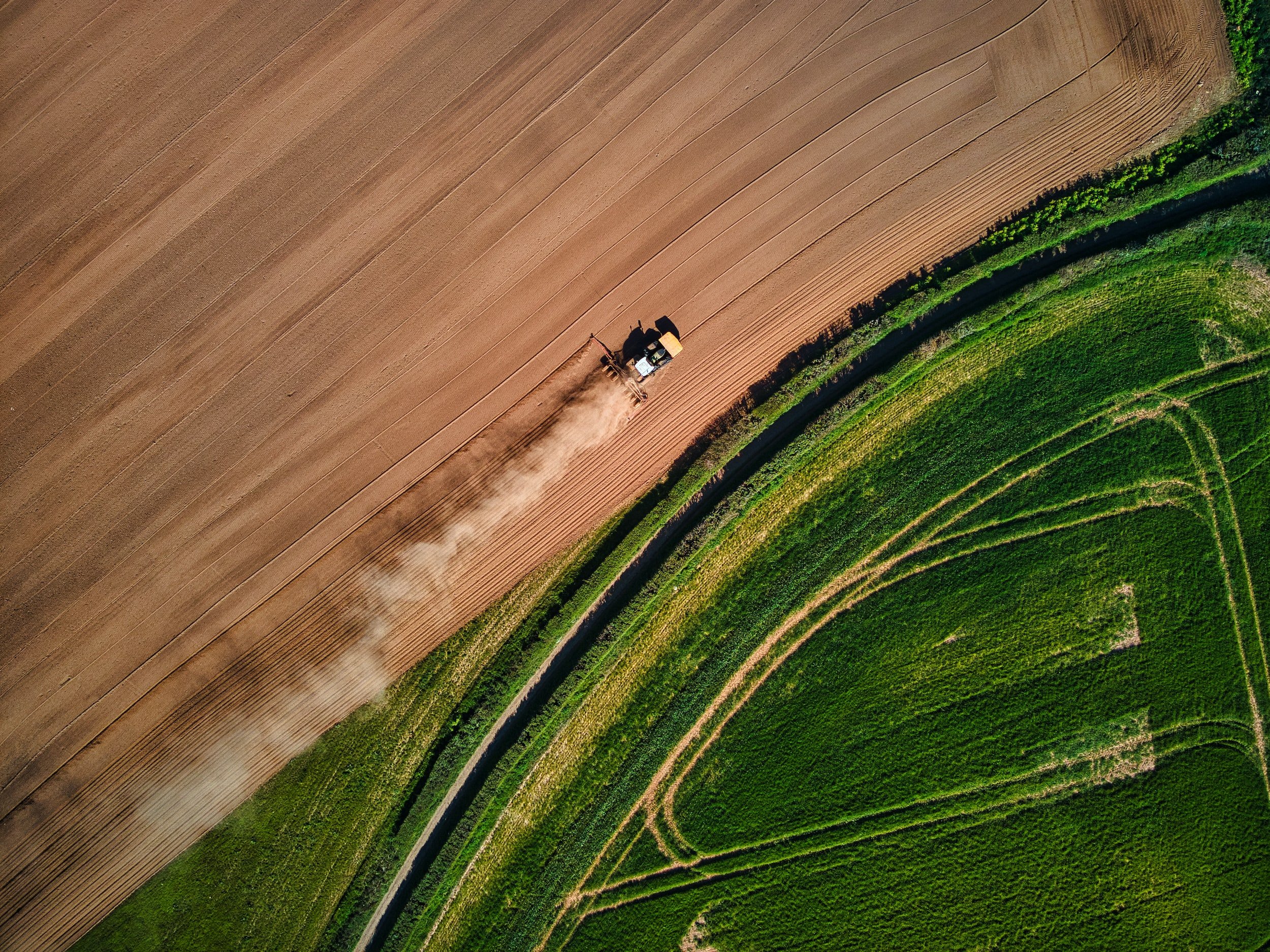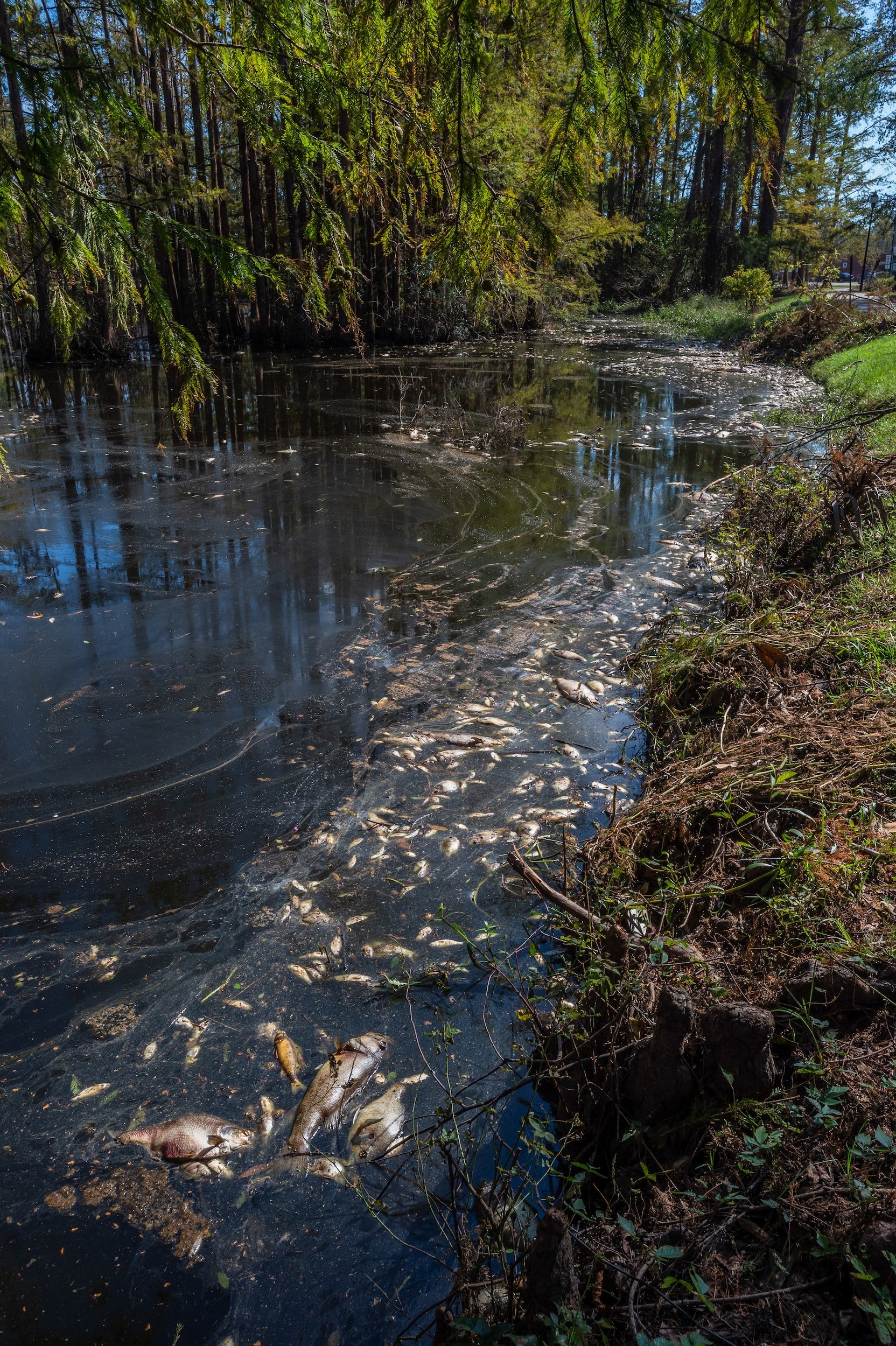runoff
Runoff is one of the most challenging problems faced when trying to reduce ocean pollution. It can include oil, chemicals, fertilizers, pesticides, sediment, salt, bacteria and nutrients and come from many sources: roads, agricultural land, construction sites or residential areas. Picked up by rain or melting snow and carried over and through the ground, the pollutants are eventually transported into the ocean where they have a disastrous effect.
Runoff from agricultural land has one of the greatest impacts as it includes fertilizers with phosphorus, nitrogen and potassium used regularly to support growth and protect crops. If the crops do not take up all the fertilizer or if rain has a chance to wash it off the fields before the plants absorb it, excess fertilizer enters the groundwater or is washed into streams, from where it heads towards the ocean.

red zeppelin/Unsplash

Liz Harrell/Unsplash

Jo-Anne McArthur/Unsplash

James Baltz/Unsplash
What effect does it have on the ocean?
Excess fertilizer from agricultural land which runs into the ocean continues to do its work: the increased nutrients in the water stimulate an excessive growth in aquatic plants and cyanobacteria or blue-green algae, leading to what have become known as algal blooms. This process is known as eutrophication. It is further supported by the introduction of untreated wastewater from both sewage and industry and from atmospheric sources of nitrogen, where higher levels of nitrogen from the burning of fossil fuels enter the hydrological cycle and are deposited on land and water in rain or snow. As algal blooms develop they can release harmful toxins and obscure the waters below them, blocking sunlight from reaching marine life beneath the surface of the water and preventing photosynthesis. The water can turn a toxic blue, green or even pink, multitudes of fish can die and a foul, sewage-like stench can be emitted from it.
Deoxygenation of the area follows on from eutrophication when the algal blooms die. As the algae sink and decompose in the water, they are consumed by oxygen-dependent bacteria which steadily decrease the supply of oxygen available to other marine life. When water approaches oxygen levels of less than 2 to 3 milligrams per litre, anything mobile like crabs, snails, and fish, will try to move away, making it harder for larger marine animals to find their usual prey. Sedentary species such as sponges, molluscs or coral polyps simply cannot exist in these zones, without the option to move on they perish.
Dead or hypoxic zones, where oxygen levels are too low to support marine life can be found all over the world in coastal areas, in particular near estuaries. Some hypoxic zones are layered, fresh water flowing in from rivers does not always mix with lower, denser and more saline hypoxic waters until storms and tides force them to combine. Anoxic zones are those without oxygen, without life, where only microbes can survive.
With a marked increase in the use of fertilizer since the 1960s, the number of dead zones has doubled. Today over 500 dead zones exist around the world, most are found along the coastlines of the Baltic Sea, Japan, the Korean Peninsula and the east coast of the USA. One of the largest hypoxic zones lies in the Gulf of Mexico where the Mississippi River drains about one third of the freshwater of the United States and with it, high levels of nitrogen and phosphorus from agricultural land and sewage. The zone varies with the agricultural seasons, growing every year from about 5,000 square kilometres early in the year to 22,000 square kilometres at the end of the summer.
Without global regulation of runoff and with the added element of climate change, hypoxic areas are expected to spread. Not only does warm water hold less dissolved oxygen than cool water, it also tends to divide into layers that don’t readily mix, meaning that the oxygen-rich shallow waters don’t mix with the deeper waters, stifling those areas even further.
Graph: Ocean Atlas 2017, Petra Böckmann/Heinrich Böll Foundation
The effect of agricultural runoff is documented by statistics available on the website of the Global Partnership on Nutrient Management, a partnership created in 2009 by the FAO together with States, industry and civil society to promote effective nutrient management and limit the negative impact of nutrients on the environment. According to their website:
Human activities produce around 120 million tonnes of reactive nitrogen each year, much of which (nearly two thirds) ends up polluting air, water, soil marine and coastal areas, and adding harmful gases to the atmosphere;
Some 20 million tonnes of phosphorous are mined every year and nearly half enters the world’s oceans - 8 times the natural rate of input;
Worldwide, the number of coastal areas impacted by eutrophication caused by excess nutrients stands at over 500; and
Dead zones in the world’s oceans have increased from 10 cases in 1960 to 405 documented cases in 2008 (169 identified hypoxic areas, 233 areas of concern and 13 systems in recovery).
Graph: Ocean Atlas 2017, Petra Böckmann/Heinrich Böll Foundation
What are we doing about it?
The solution is to try to combat pollution at its source. While much runoff is impossible to control, working with farmers to use reduced amounts or different methods of fertilization or to implement methods which prevent further nutrients from entering the ocean can help. For this a review of agricultural management practices can improve soil and therefore crop qualities and inevitably result in a lower impact on the marine environment
In 2009, the United Nations Commission on Sustainable Development established the Global Partnership on Nutrient Management (GPNM), a global mechanism to bring together and harmonize efforts to address the nutrient challenge among stakeholders. These included government, research and academia, agricultural and fertilizer producer organizations in the private sector, regional and international intergovernmental organizations and non-governmental organizations. Its ongoing work encourages State to adopt policy for an effective nutrient management.
In 2010, the Conference of the Parties to the Convention on Biological Diversity adopted the Strategic Plan for Biodiversity 2011-2020, including the 20 Aichi Biodiversity Targets with Target No. 8 aiming to improve agricultural practices and prevent runoff (“By 2020, pollution, including from excess nutrients, has been brought to levels that are not detrimental to ecosystem function and biodiversity”) but the problem persists. In 2018 the Kiel Declaration on Ocean Deoxygenation called for strategies to slow and eventually reverse deoxygenation and its ecological impacts to be co-developed between science and other stakeholders.


